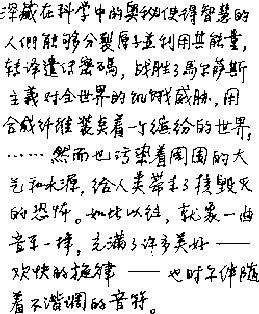

The secrets hidden in the science have allowed thinking man
to split the atom and harness its power, translate the genetic
code, defeat Malthus' threat of world starvation (a century ago),
clothe a colourful world in synthetic fibers ... while polluting
the airs and waters around us, bringing nuclear threat to the
mankind. So it goes! Like piece of music, most for the
good - cheerful sounds - dissonant notes now and then.
The role mathematics played in science has two inter-related aspects: it provides a machinery to compute quantitative results and it provides a language to structure our ideas. While the former is extremely powerful in making science to contribute to our material world in terms of technology, the latter elevates science to the realm of pure logic and philosophy and transcends to a form of art.
I consider myself a biologist who learned enough mathematics to be a member of the applied mathematics community.
Let me start with an observation: we all learn physics in high school, about mechanics, electricity, etc. But in college, we have to learn the same material again. However, there is a crucial difference: the college physics is taught in the language of calculus and differential equations, while in the high school physics is taught using simple algebra. The truth is that most of the problems solved in college can be solved using simple algebra - it is just much more difficult. It requires true talent. However, if one learns calculus, then many of the difficult high-school physics problems become simple calculus exercises.
This example shows that mathematics is *not* just a way to compute things - that is the engineering tradition. In physics and chemistry, the more profound contribution of mathematics is that it becomes *the* language for the sciences. The narrative of physics (and chemistry) is written in a mathematical language. In fact, when we learn physics, we usually don't even realize that these are just mathematical models!
The situation in biology today is very much like the high school physics - it is a science based on common language and simple mathematics. Biologists, as engineers, now are aware of that mathematical modeling and computations can contribute a great deal to the field - that is why NIGMS is interested in funding computational/ mathematical biology. But the objective there is still engineering - to solve problems, to make predictions, to help biologists. I think NSF Division of Mathematical Sciences should have an even more *basic* mission, that is gradually transforming the language of biology into a mathematical language. This, only this, will make the biological science in the future as rigorous as the physical sciences.
It is clear that most biologists, even many of the applied mathematicians, do not see this side of the mathematical biology. However, I consider this extremely important, if not more. It is also true that this is a much more difficult tast than modeling and computational predictions. The latter the biologists can appreciate. The "mathematicalize biological narritives", however, has to be carried out by a new generation of mathematical biologists who are *both* biologists and mathematician; and NSF could play an important role in fostering research and education along this mission.
A final comment: How to differentiate someone is talking about just mathematics without physics content, and someone is talking about physics in terms of mathematics? This is impossible for someone who is not trained in physics and mathematics. But for people trained in the mathematics and physics, this is obvious! There goes the difficulty in differentiating proposals with only mathematics without biology, and proposals talking about biology using mathematical language.
I would like to share with you the last sentense I wrote for a book review: "In all, Keener and Sneyd's Mathematical Physiology is an ambitious and, for the most part, successful effort to open a new genre of mathematical biology. No longer mathematics is just a helpful tool in biological research; it is gradually becoming one of the possible narratives for biology science itself. It directs students to become, not merely skilled technicians in biological research, but masters of the science."